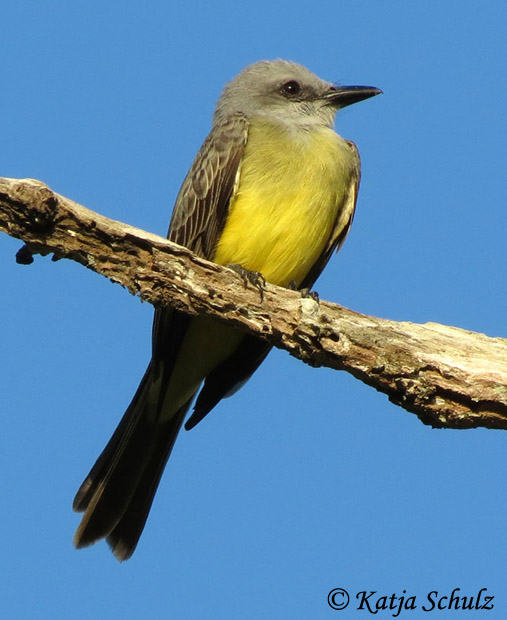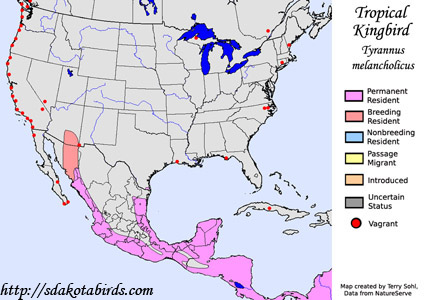| Length: 9.25 inches | Wingspan: 14.5 inches | Seasonality: Non-resident in South Dakota |
| ID Keys: Bright yellow underparts, olive-green back, brownish wings and tail, gray head with darker area around eye | ||
 The
Tropical Kingbird is a common bird of the tropics with a range that just
reaches the United States in southern Arizona, and recently, in southern
Texas. They are very similar to the Couch's Kingbird, and cannot
easily be differentiated from that species except by voice. They have
adapted well to a human presence, and given their preference for semi-open
habitats, their numbers have greatly increased upon clearing of tropical
forestlands. They have also learned to live in and around human
environments, such as suburban settings.
The
Tropical Kingbird is a common bird of the tropics with a range that just
reaches the United States in southern Arizona, and recently, in southern
Texas. They are very similar to the Couch's Kingbird, and cannot
easily be differentiated from that species except by voice. They have
adapted well to a human presence, and given their preference for semi-open
habitats, their numbers have greatly increased upon clearing of tropical
forestlands. They have also learned to live in and around human
environments, such as suburban settings.
Habitat: In their small U.S. breeding range, Tropical Kingbirds are most often found in riparian groves such as cottonwoods along rivers and streams. In the rest of their tropical range, they can be found in a variety of semi-open habitats, including farmland, savannahs, open woodlands, and even suburban areas.
Diet: Feeds on insects and spiders, but has also been known to eat fruits and berries, particularly in the more tropical parts of its range.
Behavior: Forages by observing from a perch, and flying out to capture insects in flight, or dropping down to the ground to capture insects.
Nesting: The nest of a Tropical Kingbird is a cup built of grasses, sticks, bark strips, weed stems, and other plant material, lined with softer materials such as plant down and moss. The female usually lays 3 or 4 eggs, and she alone incubates them. When the eggs hatch, both parents help to feed the young. The young fledge after about 18 days.
Song: Song of a Tropical Kingbird is a metallic, rapid series of tinkling notes.
Migration: In most of their range, Tropical Kingbirds are considered permanent residents. Those that breed in Arizona, however, are only present during the summer breeding season, although oddly, those that have bred in southern Texas have overwintered. After the breeding season, young, first-year birds are known to wander, with a handful found along the U.S. Pacific Coast every fall.
Interactive eBird Map: Click here for access to an interactive eBird map of Tropical Kingbird sightings
Similar Species: In range, most likely to be confused with Couch's Kingbird, Cassin's Kingbird, or Western Kingbird.
Conservation Status: Populations are widespread and are thought to be increasing. The IUCN lists the Tropical Kingbird as a species of "Least Concern".
Further Information: 1) BirdLife International - Tropical Kingbird
2) Whatbird - Tropical Kingbird
3) Texas Breeding Bird Atlas - Tropical Kingbird
Photo Information: Photo taken by Katja Schulz - February 6th, 2012 - Gamboa, Colon, Panama - Photo licensed under Creative Commons Attribution NonCommercial 2.0 Generic License.
| Click below for a higher-resolution map |
 |
| South Dakota Status: Non-resident in South Dakota |
Additional Tropical Kingbird Photos (coming soon!!)
